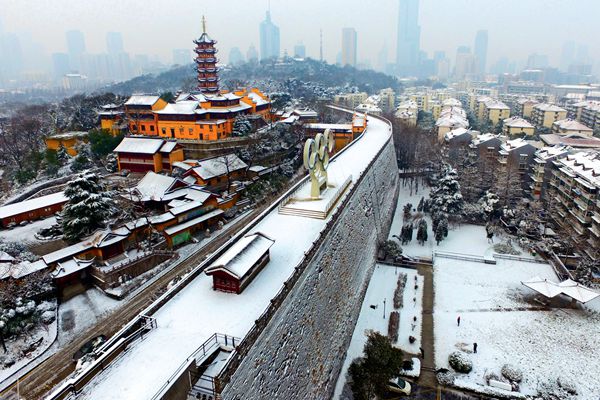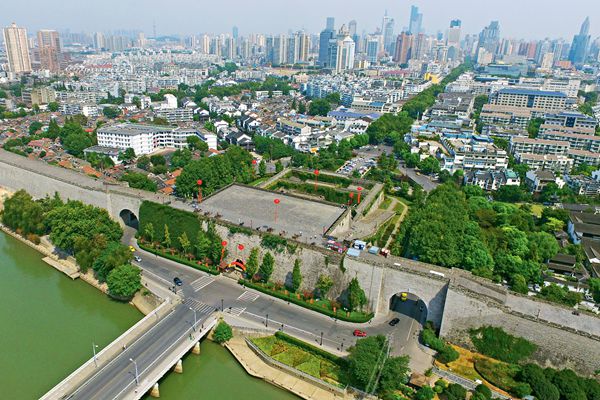NANJING, which used to be known as Jinling or Jian-kang, is the capital city of Jiangsu Province, on China’s east coast. As one of the four ancient capitals, Nanjing is a cradle of Chinese civilization as well as a political, economic, and cultural center.
Sun Quan, Emperor of Wu (222-280) was the first ruler to make Nanjing the capital in 229 AD. The last time the city became the capital was during the Republic of China period (1912-1949). Nanjing has been a capital city, on and off, over a longer period of time than any of the other ancient capitals. The successive dynasties and huge social changes that occurred over that period endowed wealth on its residents during times of prosperity and wrought penury on them on its decline. Nanjing nonetheless proved resilient, recovering time and time again to witness the country’s revitalization and playing an integral role in preserving Chinese culture and passing it down the generations.

An aerial view of Nanjing’s city wall and Jiming Temple in the snow.
The city was also the site of major events such as the signing of the Treaty of Nanjing, which marked the start of the modern period of China (1840-1949), and the establishment of the Republic of China, heralding the period’s more favorable conclusion.
Nanjing’s glorious cultural heritage, formed over centuries, is evident in the historical sites interspersed among its modern skyscrapers. The city is, in effect, a museum of Chinese history. A visit there offers the chance to recall and reflect on China’s glorious but often turbulent past.
The city wall built in the Ming Dynasty was as long as 33,676 meters. More than 600 years later, 21,351 meters of wall still stands, making it China’s longest extant city wall.
Capital of Six Dynasties
Nanjing was in fact China’s capital for more than 10 dynasties. So why is it generally known as Capital of Six Dynasties?

The city wall built in the Ming Dynasty was as long as 33,676 meters. More than 600 years later, 21,351, making it China's longest extant city wall.
The Six Dynasties refers to the specific period of Chinese history from 222 to 589, during which time there were Wu (222-280), Eastern Jin (317-420), and four successive dynasties – Song, Qi, Liang, and Chen – which are normally collectively called the Southern Dynasties (420-589).
All these states maintained their capital at Nanjing, hence the nickname, “Capital of Six Dynasties.”
At that time Nanjing was a metropolis by any standards, with a population exceeding one million. The first city to adopt a symmetrical layout with the north-south axis at its center, Nanjing’s architectural design exerted a far-reaching influence on later generations both in China and other East Asian countries. It is outstanding in the history of development of China’s ancient capitals.
Nanjing was named capital upon the establishment of the Southern Tang Dynasty (937-975). The stable social environment over the next 39 years brought both economic and cultural development, particularly in literature, art, calligraphy, and music.
Li Yu (937-978), the last Southern Tang ruler, was culturally versatile, excelling in calligraphy, painting, poetry, and music. His poetic works, especially in the form of Ci (also called lines of irregular lengths), have been appreciated for generations.

A museum that reflects the Chinese imperial civil examination system is built on the site of Jiangnan Examination Hall.
In 1368, Zhu Yuanzhang (1328-1398) proclaimed himself emperor in Nanjing and established the Ming Dynasty (1368-1644). Nanjing thus became the designated national political, economic and cultural center. Zhu spent 27 years designing and building a city wall – 33,676 meters long – to encircle his capital. More than 600 years later, 21,351 meters of wall still stands, making it China’s longest surviving city wall.
In 1421, the third Ming emperor moved the capital to Beijing, and Nanjing was demoted to a secondary capital. The grand Ming Palace was destroyed by successive wars and disasters in later centuries, but people can still catch a glimpse of its architectural style and innovation through Beijing’s Forbidden City, which was modeled on the Ming Palace.
In 1842, at the end of the First Opium War, Britain and the government of Qing Dynasty (1644-1911) signed the Treaty of Nanjing, marking the start of the modern period of China.
In 1853, during the Taiping Rebellion launched by peasants from South China, the Taiping Army captured Nanjing as its seat and held the city for 11 years.
In 1912, Dr. Sun Yat-sen announced the establishment of the provisional government of the Republic of China in Nanjing, and was inaugurated as Provisional President of the Republic.
On April 23, 1949, the People’s Liberation Army captured Nanjing, so ending the Kuomin-tang’s status as the ruling political party of China’s mainland.
After the founding of the People’s Republic of China in 1949, Nanjing was designated capital city of Jiangsu Province.
Home of Talents
Nanjing has a tradition of reverence for culture and education, and so has the reputation for being a “center of culture under heaven.”
The first Imperial College in Nanjing was established way back in the third century. The Six Dynasties period saw the establishment of schools specifically for teaching Confucianism, metaphysics, literature, and history.

An aerial view of Zhonghuamen Gate in the Ming City Wall, Nanjing.
During the Ming Dynasty, the Guozijian (or the Imperial Academy), the highest institution of learning of that time, was established in Nanjing. It was generally assumed that those who could enter Guozijian would become virtuous and knowledgeable, and hence useful and important to the state.
Jiangnan Examination Hall, which has the capacity for 20,000 examinees at one time, was the largest of its kind in ancient China. It was used to host provincial and national level examinations for students from Jiangsu and neighboring Anhui Province.
During the Ming and Qing dynasties, half the candidates for all sessions of the national examinations came from the Jiangnan Examination Hall. Among them were Tang Bohu, one of the “four literary masters of the Jiangnan region;” Wu Cheng’en, author of Journey to the West; Wu Jingzi, author of the novella The Scholars (Rulinwaishi); Zheng Banqiao, painter and one of “eight eccentric painters of Yangzhou;” and Chen Duxiu, a forerunner of the modern democratic movement.
Nanjing is the birthplace of Cao Xueqin (c.1715-c.1763), author of A Dream of Red Mansions, which is regarded one of the greatest works of Chinese literature. As his clan had held the office of Imperial Textile Commissioner in Jiangning (another name of Nanjing) for three generations, Cao’s childhood was well-to-do and carefree.
However, as family fortunes declined, Cao moved with his family to Beijing. This loss of status and the suffering it brought to each family member is reflected in Cao’s masterpiece A Dream of Red Mansions.
The voluminous novel, known, admired, and enjoyed throughout the world, is generally acknowledged as the epitome of Chinese literary excellence.
The Compendium of Materia Medica, (Bencao Gangmu) was written by Li Shizhen (1518-1593) during the Ming Dynasty and first published in Nanjing. Li spent almost 30 years on the first draft of the book, which detailed all known medical knowledge and experience. It recorded 1,095 herbal remedies, accounting for 58 percent of all known medicines.
In 1590, it was finally printed and published in Nanjing, 12 years after Li completed the book. Widely acclaimed, it has been reprinted countless times.
The Yongle Encyclopedia (known as Yongle Dadian in Chinese), the largest of its kind in ancient China, was also compiled and completed in Nanjing. A massive collection of works embracing Chinese science and culture in its entirety, the work consists of 22,937 manuscript scrolls in 11,095 volumes that bear around 370 million Chinese characters.
Most copies of the Yongle Encyclopedia were stolen or destroyed during years of wars and social turbulence, and today only around 800 scrolls of the original manuscript are preserved around the world.
The prominent Chinese mathematician and astronomer Zu Chongzhi (429-500) was also born in Nanjing. He was the first to calculate the sixth and seventh decimal places of Pi from 3.14159 to 3.1415927. The accuracy of Zu’s estimate remained unsurpassed until the Persian Astronomer and mathematician Al-Kshn (1380-1429) took Pi to the 16th decimal place about 1,000 years later.
Unforgettable History
Nanjing has experienced both boundless prosperity and bitter deprivation.
For the most part, the city historically served as a center for rump states. It was both blessed and cursed by its superior location and ideal cultural environment. Completely destroyed six times during years of wars, it bounced back and continued to thrive.
The first devastation occurred in 327 during the Eastern Jin Dynasty (317-420), when a large scale rebellion broke out. The rebel army captured the city and burned down the imperial palaces, leaving the capital in ruins.
The second was in 548, when a rebellion broke out against the Liang Dynasty (502-557). The rebel army captured Nanjing, burning down the homes of local inhabitants as well as prominent buildings and the city gates. Rebel troops then channeled water from Xuanwu Lake to inundate the imperial palace and central offices. The once prosperous city was pillaged and laid to waste, its civilians either killed or left to starve to death.
The third annihilation occurred when the Sui Dynasty (581-618) overthrew the Chen Dynasty (557-589). Founding Emperor Wendi of Sui ordered the complete destruction of Nanjing. The official mansions and grand imperial palaces were accordingly dismantled.
During the Sui and Tang (618-907) dynasties, the central authorities gave less financial support to Nanjing as it was no longer the capital city. However, its advantageous geographical location propelled the region’s economic and cultural progress. During the Southern Tang Dynasty (937-975), Nanjing was once more declared the capital, and the city expanded with the launch of various construction projects. Nanjing has since continued to play a main role in Southeast China’s economic development.
At the onset of the Southern Song Dynasty (1127-1279), although Nanjing was no longer the capital, it suffered a fourth disaster due to its location. Rivals from northern China moved south to attack the Southern Song, and captured Nanjing on their way in 1129. The following year, after ransacking and confiscating large fortunes, they interned civilians and burned down the entire city.
Nanjing’s fifth devastation came in the 19th century. In 1853, the Taiping Rebellion forces captured the city and made it the seat of the rebellion. They destroyed Nanjing, demolishing the palace and many ancient temples built during the Ming Dynasty to obtain the construction materials necessary to build their own palace.
Even worse was the havoc the Qing army wrought in 1864, when it captured Nanjing from rebels and reportedly kept the city burning for seven days, completely destroying its fine architecture.
Nanjing’s final devastation occurred on December 13, 1937, the day that Japanese invaders occupied Nanjing. In the course of the ensuing month, Japanese troops carried out the infamous Nanjing Massacre, killing civilians, desecrating culture relics, and burning down ancient residential houses and cultural sites.
It is difficult to believe that Nanjing, the beautiful and prosperous city of today, survived so many catastrophes. History serves as a reminder of our need to respect and preserve a peaceful life, and do our utmost to avoid the misery and death that wars bring.
(Compiled by China Today)





